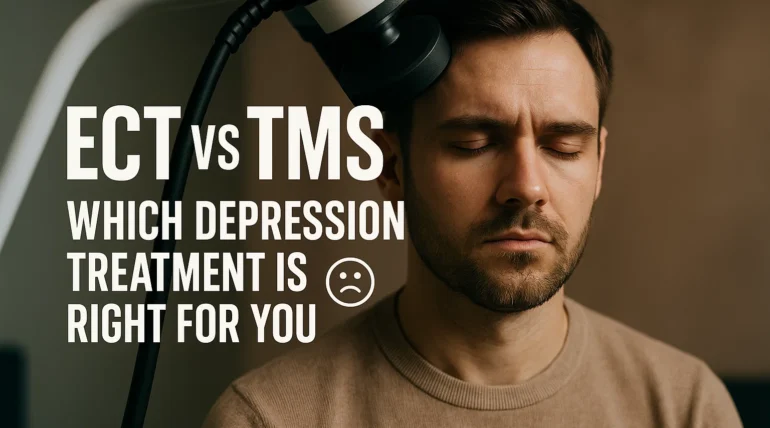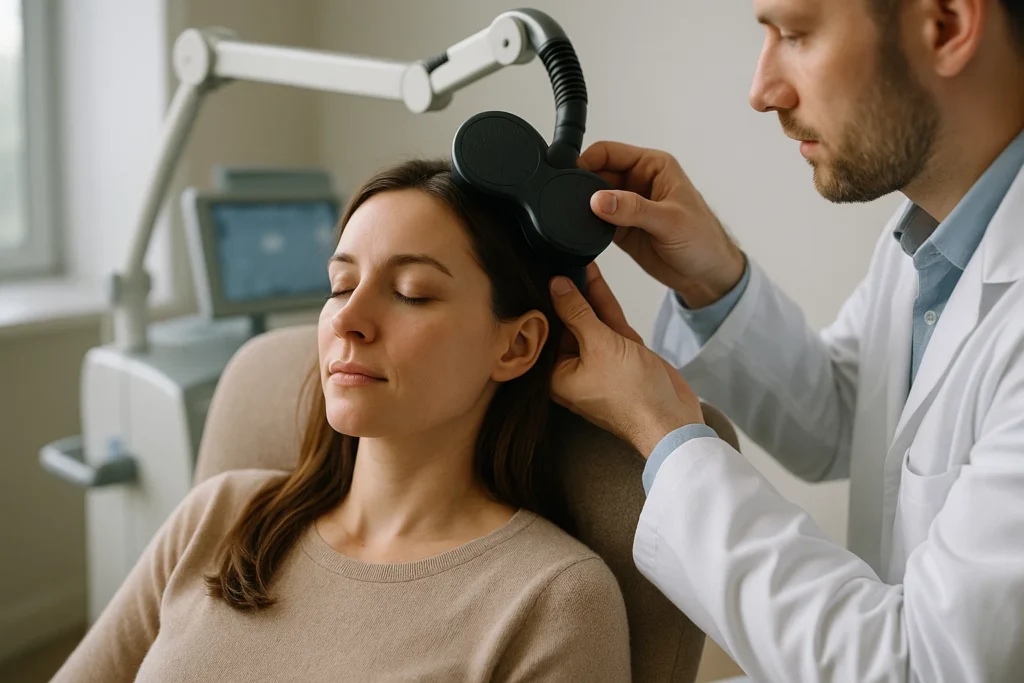
Electroconvulsive Therapy (ECT) and Transcranial Magnetic Stimulation (TMS) ECT and TMS are two of the more widely known brain stimulation treatments employed primarily for major depressive disorder (MDD), most often when medications or psychotherapy have proven insufficient. Both act on the brain to ameliorate symptoms of depression but are fundamentally different in modality, technique, side effects, efficacy and patient experience. Let’s compare and contrast ECT and TMS in depth to make it easier for you to understand ECT vs TMS.
What is ECT and How Does It Work?
Electroconvulsive Therapy (ECT) is a procedure used to treat certain psychiatric problems. Though it may sound horrifying, modern ECT is far safer than most people presume and can be a life-saving treatment for people who haven’t improved using other treatments. It is done by trained doctors in hospitals with many safety precautions.
How ECT Works:
• Small electric currents: Doctors pass small electric currents through your brain to trigger a short, controlled seizure
• General anesthesia: You receive medicine that puts you completely to sleep, so you don’t feel anything and don’t remember the surgery
• Brain gets a “restart”:The seizure can “reboot” brain circuits that aren’t working correctly (think rebooting a computer)
• Balances chemicals in the brain: Restores normal levels of mood chemicals such as serotonin which makes you feel better
• Requires multiple treatments: Typically, 6-12 sessions over several weeks are necessary to get the best results
• Hospital facility: Performed in a secure medical facility with medical doctors, nurses and anesthesiologists in attendance
What is TMS and How Does It Work?
One of the newer, gentler treatments for depression, which doesn’t require surgery or putting you to sleep is called transcranial Magnetic Stimulation (TMS). It’s F.D.A.-approved and works best for people who haven’t had luck with antidepressants or therapy. And it is well-liked by many people because it has less severe side effects than other treatments.

How TMS Works:
• Magnetic pulses to your brain: This treatment involves the use of strong magnets similar to those used in an MRI machine, which are directed at your brain to gently stimulate certain parts that regulate mood
• Stay awake the whole time: No anesthesia required – You only sit with a reclining chair (mess with your phone, watch TV, listen to music while you vape)
• Targets the right spots:-regulating brain structures – Physicians apply magnetic coils to your head targeting precise areas that help control your emotions
• Helps brain cells grow: Stimulates your brain to grow new cells and strengthen the connections between them that make you feel better
• Fast office visits: It only takes about 20-40 minutes per session and can be done in your doctor’s office
• Gradual improvement: Typically improves over time, requires 20-30 visits for many weeks(fullfile figure legend)
• Mild reactions: Most people only experience a mild headache or a little bit of soreness where the coil was placed on their head
• Back to normal in no time: you can drive home and return to your normal daily activities right away after treatment
Key Differences Between ECT and TMS
| Aspect | Electroconvulsive Therapy (ECT) | Transcranial Magnetic Stimulation (TMS) |
| Mechanism | Electrical currents induce generalized brain seizures | Magnetic pulses stimulate nerve cells in targeted brain areas |
| Invasiveness | Invasive, requires general anesthesia and seizure induction | Non-invasive, no anesthesia or seizures needed |
| Treatment Setting | Hospital setting with anesthesia and monitoring | Outpatient clinic without anesthesia |
| Duration & Frequency | Sessions typically last a few minutes; multiple sessions over weeks | Sessions last about 40 minutes; typically daily over several weeks |
| Side Effects | Memory loss (short-term), confusion, anesthesia risks | Mild headaches, scalp discomfort, generally well-tolerated |
| Efficacy | Higher short-term efficacy, especially for severe or psychotic depression | Effective for treatment-resistant depression but with slightly lower efficacy |
| Cost | Generally higher due to hospitalization and anesthesia | Lower cost; more accessible outpatient procedure |
| Patient Preference | Lower due to invasiveness and side effects | Higher due to comfort and minimal side effects |
Effectiveness
Research indicates that short-term antidepressant effect may be greater with ECT than TMS. For instance, ECT may have between a 64.4% and 53% response rate, and remission rates between 64.4% and 53%, whereas high frequency TMS varies in response rates from 48.7% to 32.2%. ECT also indicates more decrease in suicidal acts when compared with TMS. However, TMS might be better tolerated in the long term and have fewer cognitive adverse effects, thus making it more suitable for some patients who would reject ECT because of fear or contraindications.
Side Effects and Tolerability
The side effects of ECT, including short-term memory loss and potential hazards due to anesthesia, render the therapy more intensive and challenging. In comparison, TMS is generally regarded as safe and has few side effects, often only short-lived headache or a mild degree of discomfort at application site, which is brief in duration.
Cost and Accessibility
ECT is expensive because of the need for anesthesia and hospital treatment. TMS and OTMS are cheaper and more available on an outpatient basis. TMS is more accepted by patients as it is non-intrusive and has fewer side effects.
Making the Right Treatment Decision

ECT and TMS are effective and FDA-approved treatments for depression, especially for patients with treatment-resistant depression. ECT is believed to be more effective in cases of severe conditions and short-term, but is associated with more risks and side effects. TMS is a low-invasive, well-tolerated, safe, and moderately effective alternative.
The choice between ECT and TMS needs to be individualised and rely on the strength of the symptoms, physical fitness, the wish of patient, and available resources. You should make sure that you consult with a board-certified psychiatrist or neurologist and settle on which option would best suit you. These two therapies are significant milestones in the mental health care field and give hope to patients who otherwise have not been relieved by conventional treatment.
At Minds Over Matter, our highly qualified mental health experts are ready to walk with you through your choices and make the right decision to undergo ECT, TMS, or other treatment options that may suit you.
FAQs
ECT uses electric currents controlled to induce a temporary seizure in a general state of anesthesia and targets the whole brain, but TMS uses magnetic pulses that are targeted to stimulate specific regions of the brain in the absence of anesthesia or seizures.
ECT is generally regarded as more effective in treatment resistant and severe depression, and it has rapid symptomatic action. TMS is effective, however, it is less effective in the acute setting but has shown long-term effects and better tolerability
ECT therapies are usually given 2-3 times per week of 6-12 sessions that may require inpatient or day hospitalization. TMS is usually given 5 days a week (daily) in 4-6 weeks on outpatient basis.
TMS is non-invasive, has few side effects, and does not require anesthesia, which makes it more popular among many patients who believe that it may be less effective than ECT.
TMS is a very good alternative in patients who cannot tolerate ECT or prefer a less invasive procedure but ECT is the gold standard in very severe, psychotic, or treatment-resistant depression, especially when a quicker resolution of symptoms is needed.


